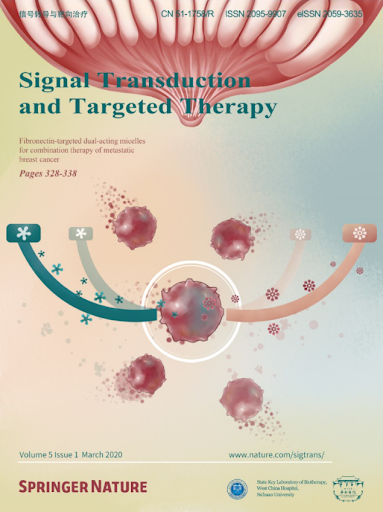Platelets and diseases: signal transduction and advances in targeted therapy.
IF 52.7
1区 医学
Q1 BIOCHEMISTRY & MOLECULAR BIOLOGY
引用次数: 0
Abstract
Platelets are essential anucleate blood cells that play pivotal roles in hemostasis, tissue repair, and immune modulation. Originating from megakaryocytes in the bone marrow, platelets are small in size but possess a highly specialized structure that enables them to execute a wide range of physiological functions. The platelet cytoplasm is enriched with functional proteins, organelles, and granules that facilitate their activation and participation in tissue repair processes. Platelet membranes are densely populated with a variety of receptors, which, upon activation, initiate complex intracellular signaling cascades. These signaling pathways govern platelet activation, aggregation, and the release of bioactive molecules, including growth factors, cytokines, and chemokines. Through these mechanisms, platelets are integral to critical physiological processes such as thrombosis, wound healing, and immune surveillance. However, dysregulated platelet function can contribute to pathological conditions, including cancer metastasis, atherosclerosis, and chronic inflammation. Due to their central involvement in both normal physiology and disease, platelets have become prominent targets for therapeutic intervention. Current treatments primarily aim to modulate platelet signaling to prevent thrombosis in cardiovascular diseases or to reduce excessive platelet aggregation in other pathological conditions. Antiplatelet therapies are widely employed in clinical practice to mitigate clot formation in high-risk patients. As platelet biology continues to evolve, emerging therapeutic strategies focus on refining platelet modulation to enhance clinical outcomes and prevent complications associated with platelet dysfunction. This review explores the structure, signaling pathways, biological functions, and therapeutic potential of platelets, highlighting their roles in both physiological and pathological contexts.血小板与疾病:信号转导及靶向治疗进展。
血小板是必不可少的无核血细胞,在止血、组织修复和免疫调节中起关键作用。血小板起源于骨髓中的巨核细胞,体积小,但具有高度特化的结构,使其能够执行广泛的生理功能。血小板细胞质富含功能蛋白、细胞器和颗粒,促进它们的激活和参与组织修复过程。血小板膜密集分布着各种受体,这些受体在激活后,启动复杂的细胞内信号级联反应。这些信号通路控制血小板的激活、聚集和生物活性分子的释放,包括生长因子、细胞因子和趋化因子。通过这些机制,血小板在血栓形成、伤口愈合和免疫监测等关键生理过程中不可或缺。然而,血小板功能失调可能导致病理状况,包括癌症转移、动脉粥样硬化和慢性炎症。由于其在正常生理和疾病中的核心作用,血小板已成为治疗干预的重要靶点。目前的治疗主要旨在调节血小板信号以预防心血管疾病中的血栓形成或减少其他病理条件下的过度血小板聚集。抗血小板治疗被广泛应用于临床实践,以减轻高危患者的血栓形成。随着血小板生物学的不断发展,新兴的治疗策略集中在完善血小板调节以提高临床疗效和预防与血小板功能障碍相关的并发症。这篇综述探讨了血小板的结构、信号通路、生物学功能和治疗潜力,强调了它们在生理和病理环境中的作用。
本文章由计算机程序翻译,如有差异,请以英文原文为准。
求助全文
约1分钟内获得全文
求助全文
来源期刊

Signal Transduction and Targeted Therapy
Biochemistry, Genetics and Molecular Biology-Genetics
CiteScore
44.50
自引率
1.50%
发文量
384
审稿时长
5 weeks
期刊介绍:
Signal Transduction and Targeted Therapy is an open access journal that focuses on timely publication of cutting-edge discoveries and advancements in basic science and clinical research related to signal transduction and targeted therapy.
Scope: The journal covers research on major human diseases, including, but not limited to:
Cancer,Cardiovascular diseases,Autoimmune diseases,Nervous system diseases.
 求助内容:
求助内容: 应助结果提醒方式:
应助结果提醒方式:


